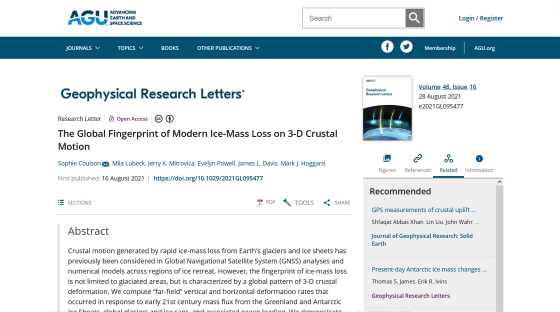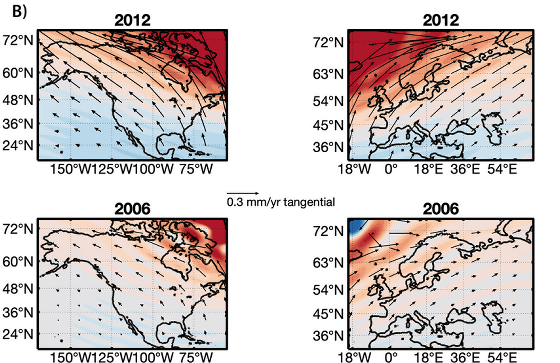It turns out that 'crustal movement' is occurring due to the melting of polar ice, even in places more than several hundred kilometers away from the ice sheet.

The melting of Arctic and Antarctic ice due to global warming causes problems such as rising sea levels and reduced habitat for polar animals. In a new study, the melting of polar ice causes the '
The Global Fingerprint of Modern Ice-Mass Loss on 3-D Crustal Motion --Coulson --2021 --Geophysical Research Letters --Wiley Online Library
https://agupubs.onlinelibrary.wiley.com/doi/10.1029/2021GL095477

Melting of polar ice shifting Earth itself, not just sea levels – Harvard Gazette
https://news.harvard.edu/gazette/story/2021/09/melting-of-polar-ice-shifting-earth-itself-not-just-sea-levels/
Vanishing ice is warping Earth's crust | Live Science
https://www.livescience.com/melting-ice-warps-earth-crust
Glaciers, ice sheets, and sea ice that exist in polar regions and high latitude regions can be regarded as a kind of 'weight' for the earth. Therefore, just as the shape of the pillow gradually returns when you take your head off the pillow of shape memory, the weight on the crust is released when the ice on the earth melts, and the shape of the crust slowly returns to its original shape. I'm going.
This phenomenon is called glacial isostatic adjustment and has long been known to scientists. Crustal movements due to melting of ice proceed at a very slow speed, so the uplift of the crustal caused by the end of the last glacial period and the melting of a large ice sheet about 10,000 years ago is still part of the present day. It is said to continue in high latitude areas.
In recent years, the rapid melting of ice in polar regions and high latitudes due to global warming has become a problem, and crustal movements are thought to be accelerating. However, most studies on glacial crustal equilibrium have focused on the crust beneath and around the ice sheet, and the direction of variation seems to have been vertically focused, making it more three-dimensional and horizontal. It seems that there is not enough research on directional fluctuations.
Therefore, the research team of Sophie Coalson, who was enrolled in the doctoral course at Harvard University at the time of research and was a postdoctoral researcher at the Los Alamos National Laboratory at the time of writing the article, said that the melting of ice that occurred in the 21st century affected the crust. We conducted research to analyze the effects of the research in a wide range of the world in three dimensions.

Using satellite data collected from 2003 to 2018, the research team detected small crustal movements and compared them to ice loss in Antarctica, the Arctic, Greenland, and other high-latitude regions. As a result, it was found that the crustal movement due to the loss of ice is often larger in the horizontal direction than in the vertical uplift, and the distance traveled depends on the amount of ice lost. We also found that crustal movements caused by melting ice can occur more than a few hundred miles away from the ice.
Polar faced a large amount of ice will each present the Southern Hemisphere and in the Northern Hemisphere, the Antarctic rapidly ice in the east of the continent while was solved in the 2000s
The researchers say that in 2012, when ice sheet losses were high, there was an average annual horizontal movement of 0.45 millimeters in the northernmost regions of the United States and Europe. Also, even in 2006, when ice sheet loss was low, it was said that the average movement was about 0.1 mm in the horizontal direction, and the average distance traveled during the survey period was 0.2 to 0.3 mm per year. In addition, although the distance traveled decreased as the distance from the polar regions increased, crustal movements of less than 0.05 mm were confirmed in regions such as the western United States and Southern Europe.
The images below show the magnitude of crustal movements in 2012 and 2006 in North America and Europe, in color and arrow lengths. It can be seen that the crust moved significantly in 2012, when the ice sheet loss was large, and moved slightly in 2006, when the ice sheet loss was small.

'On a short time scale, the Earth is considered to be like elastic rubber, but for thousands of years,' Coulson said of the long-term movement of the crust as a result of the loss of the ice sheet. On a time scale, the Earth behaves like a very slow-moving fluid. '
Crustal movements are not only manifested as a result of ice sheet loss, but can also affect the speed at which ice melts by changing the slope of the rock beneath the ice sheet. 'Understanding all the factors that cause crustal movement is very important for various geochemical problems, for example, to accurately observe crustal movements and seismic activity, by ice sheet loss,' Coulson said. The generated movements need to be separated. '
Related Posts:
in Science, Posted by log1h_ik







